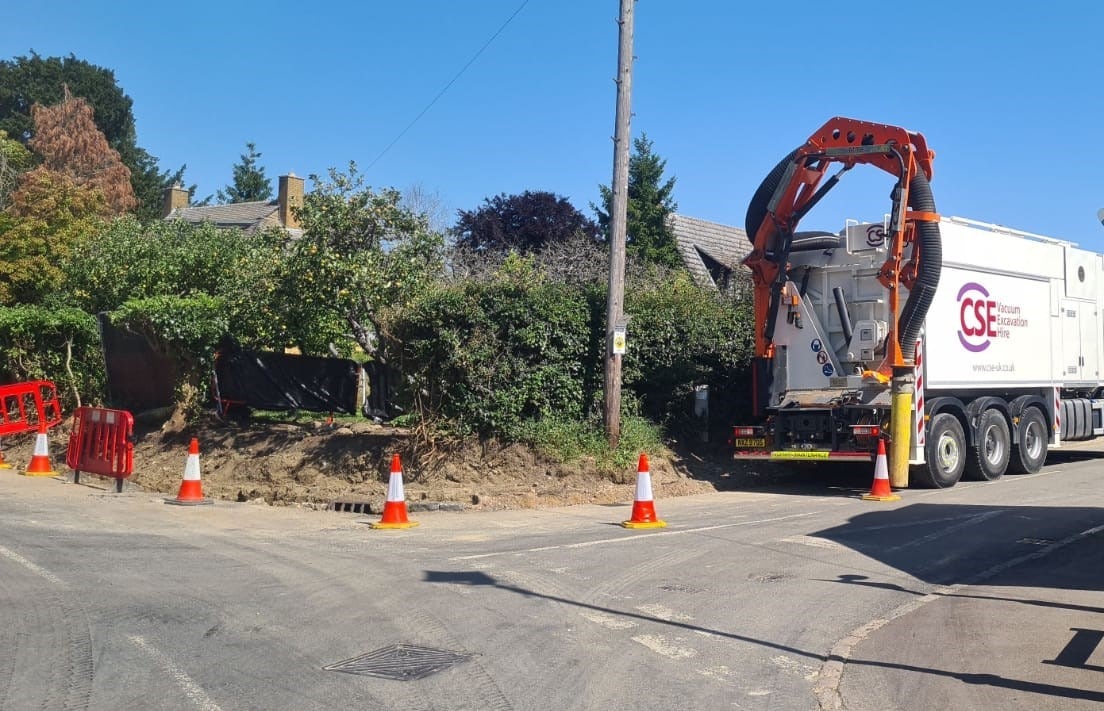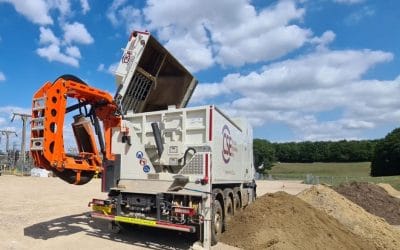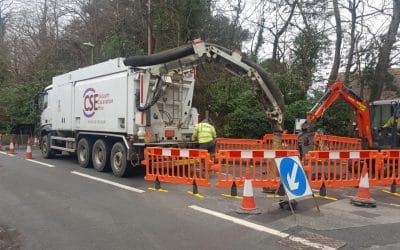What is Suction Excavation Used for?
Vacuum Excavation has increasingly become the smarter choice for safe excavation. With the use strong suction power, material can be cleared quickly whilst the remote-controlled boom ensures precision is achieved at a safe distance.
Sewage Works
The Vacuum Excavator’s large built-in skip provides a fantastic solution to remove any sludge from sewage treatment plants.
Tank Excavation
For any industrial sites with tanks, containers, bunkers and silos, the suction excavator is able to make light work of emptying out the vessels. The strong suction power provides fast clearance for removing stored material that is used for deep cleaning or to decommission old storage units.
Deep Excavation Works
For any deep excavation works, the remote-control operation of the Vacuum Boom ensures that the work can be carried out from a safe distance. Precision control means that the work carried out can be completed quickly, but in a safely controlled manner. Any extension pipework means that the work can be carried out even in hard-to-reach locations.
Trial Holes and Buried Asset Surveys
Using a Vacuum Excavator for trial holes will check the accuracy of utility location tools as well as providing a blueprint of what is buried underneath.
Exposing Underground Utilities
Using suction power to pull material away from a buried utility has several more safety benefits than traditional digging. The no-dig approach uses suction power to extract the ground material and to reduce the risk of tool causing a line strike and cutting any local utilities.
Suction Excavation offers a faster, more cost-effective solution than manual hand digging. A standard Vacuum Excavation can remove 2m3of spoil per hour, while an inbuilt skip can hold up to 10m3 before it needs to be emptied. In short, one suction excavator will complete a job in the fraction of time in which it would take a team of labourers or a digger.
Excavation for Rail Line Maintenance or Removal
Vacuum excavation is pivotal in rail line maintenance or removal. Its precise suction exposes utilities near tracks, reducing damage risks. Safely excavating around rails, it isolates utilities for preservation, ensuring minimal disruptions and maintaining critical infrastructure integrity during maintenance or removal.
Site Preparation
Vacuum excavation serves as a crucial tool in site preparation, offering precise excavation without disturbing surrounding structures or utilities. It precisely clears debris, digs trenches for foundational work, and exposes underground utilities without causing damage. By swiftly and accurately excavating, it streamlines site preparation, ensuring a safer and more efficient groundwork process. This method minimises disruptions to the site’s surroundings, reduces the risk of damage to existing infrastructure, and enhances overall project timelines by facilitating accurate and non-invasive excavation during the preparatory phase.
Landscaping
In landscaping, vacuum excavation offers non-destructive soil removal, preserving delicate root systems and underground utilities. It precisely excavates for tree planting, digs trenches for irrigation lines, and shapes terrain without harming existing flora or infrastructure. The method facilitates precision in removing soil and debris, enabling efficient installation of landscaping features while reducing disruption to the environment. Vacuum excavation’s gentle approach safeguards existing landscape elements, ensuring minimal disturbance and enhancing the overall aesthetics and functionality of the outdoor space being landscaped.
Potholing
Vacuum excavation is pivotal in potholing, ensuring precise exposure of underground utilities without damage. This non-invasive method accurately identifies utilities’ locations, facilitating safe maintenance or repair work. By excavating small, precise holes, it isolates utilities for inspection or repair, minimising service disruptions and potential hazards. Potholing with vacuum excavation significantly reduces the risks associated with traditional digging methods, preserving the integrity of existing infrastructure while providing clear visibility of subsurface utilities. This approach enhances safety, efficiency, and accuracy in utility detection and maintenance, making it an indispensable technique in various industries reliant on reliable underground infrastructure.
Trenching
In trenching, vacuum excavation offers precise, non-destructive digging. Its controlled suction efficiently creates trenches for utilities like pipelines or cables without harming surrounding infrastructure. This method accurately exposes underground services, reducing the risk of damage during installation or maintenance. Vacuum excavation’s precision ensures straight, clean trenches, optimising the placement of utilities while reducing disturbances to the surrounding environment. By safely excavating and precisely shaping trenches, it streamlines installation processes, enhancing safety, efficiency, and accuracy in trenching operations across various industries reliant on secure and carefully placed underground infrastructure.
Which Sectors Most Commonly Use Vacuum Excavation
Utility Contractors
Utility contractors rely on vacuum excavation for safe and accurate utility location. This method precisely exposes underground infrastructure without causing damage, crucial for installing, repairing, or upgrading utilities like gas lines, water pipes, or fibre optic cables. Vacuum excavation reduces the risk of service disruptions, ensuring precise identification and maintenance of utilities. Its non-invasive approach preserves existing infrastructure integrity while allowing for efficient and safe utility-related tasks, minimising risks and optimising project timelines.
Building Contractors
Building contractors utilise vacuum excavation for precise digging without compromising existing structures or utilities. This method aids in foundation work, precisely excavating for footings or utility placements. It ensures accurate soil removal around structures for additions or renovations, reducing risks to nearby utilities. Vacuum excavation’s non-destructive approach facilitates safe and efficient construction, reducing the likelihood of damage to surrounding infrastructure. This technique enables building contractors to work more safely and efficiently, maintaining project timelines and integrity.
Civil Engineering
In civil engineering, vacuum excavation plays a pivotal role in infrastructure development. Its precise and non-destructive nature aids in locating and exposing underground utilities for maintenance or relocation. This method accurately creates trenches for laying utilities or installing drainage systems, reducing the risk of damage to existing infrastructure. Vacuum excavation ensures safe and efficient project execution, reducing disruptions and optimising the integrity of subsurface structures, making it indispensable in civil engineering projects.
Highways
In highway construction and maintenance, vacuum excavation is crucial for safe utility work. It precisely exposes buried utilities without compromising road integrity. This method facilitates trenching for cable installations or drainage systems, ensuring minimal disruption to traffic flow. Vacuum excavation’s precision and non-destructive nature minimise risks of damaging existing infrastructure, allowing for efficient highway maintenance and expansion. Its role in safe, accurate utility work contributes significantly to maintaining roadway safety and functionality.
Rail
In rail operations, vacuum excavation is a vital tool for precise and safe utility and track maintenance. Its non-destructive approach exposes underground utilities without compromising rail infrastructure. Vacuum excavation aids in trenching for cable installations or repairs, while minimising disruptions to rail services. This method’s accuracy ensures the protection of critical rail infrastructure and utilities, contributing to safer and more efficient rail operations, maintenance, and expansions.
Agriculture
In agriculture, vacuum excavation aids in precise and non-invasive soil management. It assists in trenching for irrigation systems or planting trees without disturbing sensitive root structures. This method clears debris, enabling accurate installation of agricultural utilities while preserving soil integrity. Vacuum excavation’s gentle approach ensures minimal disruption to crop fields or orchards, enhancing efficiency in agricultural operations. Its role in precise soil management contributes to maintaining healthy, productive farming environments while reducing disturbances to crop growth.
Construction
In construction, vacuum excavation stands as a precise, non-destructive method for site preparation and utility work. It facilitates precise digging for foundations or utility installation, ensuring minimal disturbance to surrounding structures or services. This method’s accuracy in trenching and soil removal streamlines various construction tasks, preserving existing infrastructure integrity. Vacuum excavation enhances safety, reduces project timelines, and reduces risks associated with traditional digging methods, making it indispensable in construction projects for efficient and safe groundwork.
Equipment Used in Vacuum Excavation
Vacuum excavation relies on specialised equipment tailored for precision and efficiency. Hydro or air vacuum excavators, equipped with powerful suction, extract soil while reducing damage to surrounding utilities. These units feature debris tanks for soil storage and water tanks for hydro excavation.
Additional components include high-pressure water jets for soil loosening and cutting through tough surfaces. Tools like hoses, wands, and digging nozzles facilitate controlled excavation. Safety features such as remote operation and debris containment systems enhance operational safety. This equipment ensures accurate, non-destructive soil removal, making vacuum excavation an indispensable method across various industries.
Conclusion
Vacuum excavation offers a precise and non-invasive method that is crucial across industries. Its specialised equipment ensures accurate soil removal, preserving infrastructure integrity. From construction to utility maintenance, this technique streamlines operations, enhancing safety and efficiency. Vacuum excavation’s role as a versatile, precise tool remains indispensable in various industries.





